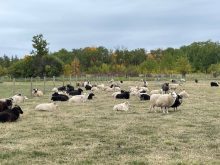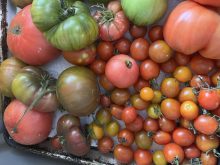Tomatoes
Tomatoes originated in South America from wild plants with grape-sized fruit. They were developed by the Indigenous peoples of the Americas. They were first brought to Europe in the 1540s, to Italy in particular by the 1550s. North Americans were slow to pick up on tomatoes, regarding them as poisonous until almost the year 1900, although they may well have been grown and consumed sparingly since the 1700s.
Today there are thousands of tomato varieties, from blueberry- and grape-sized to the giant Italian beefsteak types. I have a friend in British Columbia who propagates 8,000 varieties. Tomatoes come in either indeterminate stalking types or determinate bush types and in-between types. Tomato is always spelled tomato, not tomatoe —as is potato, not potatoe — but many Prairie Canadians insist on adding the “e” to both.
Read Also

Claas brings 1000 Series SP forage harvesters to Canada
In mid-August, Claas unveiled its new line of Jaguar forage harvesters at an event in Visalia, California, deep in the heart of that state’s dairy region.
The tomato classified as a vegetable is really a fruit, just as peppers, cucumbers, green beans, eggplants, squashes and pumpkins all are technically fruits, but we call them vegetables.
Tomatoes are available in red, brown, black, yellow and pink (pink is preferred in Quebec). They come in all sizes and shapes, from globes to cylinders. They can be early or late types, sweet or sour, fuzzy, even low in acid. I developed a very early type of tomato though crossbreeding — more by accident than by design. It’s available as the Evans Extra Early tomato, ripening 10 days or more earlier than other available types. I don’t get any income from this tomato, it’s just one I released for public use.
Tomatoes’ growing requirements
Basically tomatoes, unlike potatoes, are low in nutrients but apparently high in vitamins and other healthy properties. They can be juicy, meaty, sour, sweet or even spicy. Despite all these varieties, growers and the public all head for the brightest red, full-sized tomato.
Field crop tomatoes in Canada are grown primarily in Ontario, on around 15,000 acres, yielding some 30 to 50 tons to the acre with a value of around $115 million. Fresh market and greenhouse tomatoes provide some 260 million kilograms in Canada, primarily in Ontario at 82 million kg, B.C. at 37 million kg and Quebec at 32 million kg. Some 25 per cent of these tomatoes are exported to the U.S. and Japan. This greenhouse or fresh tomato production is valued at around $700 million. Our Prairie greenhouse tomatoes, even with our “many” greenhouses, play only a minor part in the big tomato picture.

Most farm gardens buy their tomato seedlings from nursery outlets or the big box stores in early May. Colonies usually grow their own seedlings starting in early March, with their preferred tomato varieties for transplanting out in late May.
Tomatoes require light fertilizing, preferably with ammonium phosphate at an ounce (30 grams) to a square yard. This provides the N, P and S. Epsom salts are often recommended where growers say the magnesium gives the tomatoes a boost. Not so — it’s actually the sulphur in the magnesium sulphate. Magnesium is rarely limiting in farm gardens, but sulphur is often in short supply.
Many seed- and soil-borne diseases used to plague tomatoes, but most of these issues have been resolved with clean seed and resistant varieties. The only tomato disease of consequence in the last few years has been potato late blight — which, by the way, dies out over winter. Beware of manure for tomatoes, even if you are an organic grower. How many times have I seen tomato crops ruined by manure-borne picloram — which may also include some commercial composts?
Tomatoes grown on all farms should be planted on cropland that has never previously grown tomatoes, since I have seen “old” gardens infested with various tomato root-rotting fungi. Tomatoes need full sun with lots of water to get established. Once established, tomatoes are very good soil water extractors —almost as good as sunflowers.
Plant any tomato variety you fancy, but give it full sunlight — well away from any water-robbing trees. Do not grow tomatoes in pots unless you have lots of time to water them, since they are heavy water users. You can, as I have done, leave the tomato plant in the big pot and bury the pot into the garden soil. This allows the roots to grow into the ground and tap their own water supply.
Harvested tomatoes last days or even weeks. Green tomatoes ripen after picking but they are best frozen or processed while they are at their best. If you want to make salsa, you should grow the easily grown and prolific yellow/green “tomatillo,” just as they do in Mexico.

Onions
Wales is a country where onions and leeks are just about the No. 1 vegetables. I remember, as all children there in the late 1940s would, seeing Bretons (from northwestern France) cycling around the village with hundreds of pounds of onions on strings hanging from them and their bicycles. The Welsh and Breton Celtic languages were very similar so that they could speak in Welsh as well as Breton and English. Ships would leave from Brittany in early winter with holds full of onions for British and Irish ports loaded up with tons of onions. These Breton farmers would then ply their onion strings all over the British Isles — “onion Johnnies,” as they were called.
Onions’ growing requirements
I’ve found that on the Prairies, most farm gardens would grow onions from the grape-sized sets, though on colonies they were often grown from seed. Onions are not deep rooters, so they need a good water supply in the growing season, as well as a moderate fertilizer requiring as much as two ounces (60 g) of ammonium phosphate (16-20-0-14) per square yard. In my onion-growing trials I found sulphur and copper were very important. On my very sandy soil I found that one to two ounces (30-60 g) of copper sulphate in a gallon of water was good for 70 feet (20 m) of row for growing big, robust onions.
In Ontario there are many onion diseases and disorders but there are few if any growing problems in Prairie Canada, except for dry summers affecting yield.
Checking out onion growing on the Prairies I did find two major problems: onion maggot in the growing onions and fusarium and botrytis bulb rot in storage onions. We do not have insecticides for onion maggot control and the only way I initially found to avoid them was to plant the onion sets or seedlings three inches (eight cm) deep. Seems that they were a bit deep for maggot infection. The other way, especially for isolated gardens or on colonies, was to not grow any onions for one year, which breaks the onion maggot life cycle. Onion maggots are not related to cabbage maggots.

The biggest problem I found was the method of onion harvesting. I saw commercial growers, colonies and farmers lose 80 per cent or more of their harvested onions to fungus rot. To control this problem, I remembered how they harvested onion fields in Washington state. The onions were uprooted in August, the tops were cut off close to the bulbs, and the onions were placed in a heated building for a few days to dry and cure.
To check this out, I planted three small beds of onions on University of Alberta cropland. One lot was pulled in late August and left in situ; the second lot was pulled and hung up in a good air-conditioned barn, tops and all, to “cure.” A third lot had its tops removed and was placed on chicken wire in a greenhouse to dry off. The onions left in situ were taken in after two weeks and hung up, foliage and all, in a dry airy barn. In October I cut the tops off all the hanging onions and placed them on greenhouse benches. The results were surprising, though we did have a wet August. Around 70 per cent of the onions left out to dry and cure had onion fungus rot. Some 40 per cent of the onions with tops that were hung indoors to dry had onion fungus rot. Less than five per cent of the onions that had their tops cut off and were dried on chicken wire had any fungus rot.
The solution? If you grow onions, cut off the tops as soon as you harvest them and dry them in a shed, barn or greenhouse as soon as possible.
For more specific information on tomatoes and onions, search up the publication Diseases and Insect Pests of Vegetable Crops in Canada online.
















